= Lithops hookeri var. subfenestrata C019 (syn. brunneoviolacea) TL: 40 km SW of Griquatown, South Africa
Accepted Scientific Name: Lithops hookeri (A.Berger) Schwantes
Möller's deutsche gärtner-zeitung 1928, xliii. 46. Möller
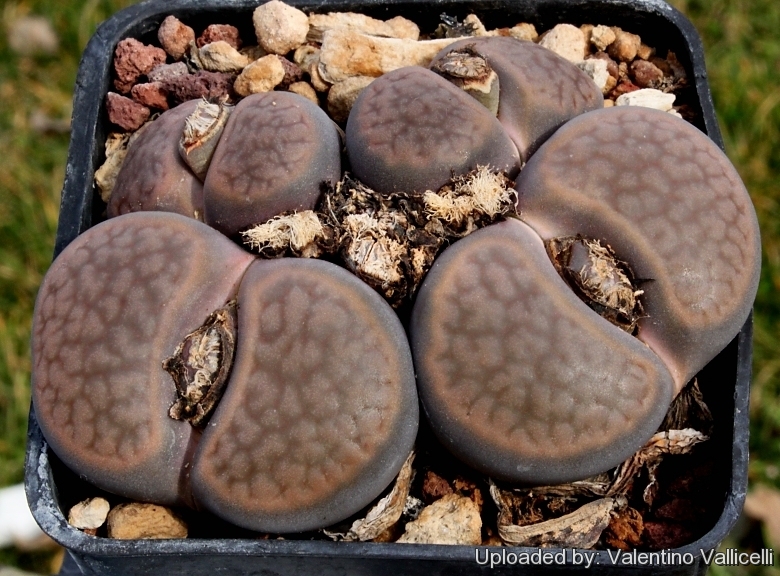
Lithops turbiniformis var. brunneo-violacea (Lithops hookeri var. subfenestrata C019 (syn. brunneoviolacea) TL: 40 km SW of Griquatown, South Africa) Photo by: Valentino Vallicelli
Nice form with unusually murky windowed apex slightly humped with a rich red-brown to violet coloration.
Origin and Habitat: TL: 40 km SW of Griquatown, South Africa.
Habitat: Lithops are an expression of particular niches, L. hookeri var. subfenestrata grows in a rocky ground among the equally shiny dark and implausibly shiny ironstone.
Synonyms:
See all synonyms of Lithops hookeri
back
Accepted name in llifle Database:Lithops hookeri (A.Berger) SchwantesMöller's deutsche gärtner-zeitung 1928, xliii. 46.Synonymy: 52
- Lithops hookeri (A.Berger) Schwantes
- Lithops hookeri C023 (vermiculate Form) 55 km SW of Prieska, South Africa
- Lithops hookeri C051 (vermiculate Form) 15 km NW of Strydenburg, South Africa
- Lithops hookeri C110 50 km NW of Marydale, South Africa
- Lithops hookeri C112 40 km WNW of Prieska, South Africa
- Lithops hookeri C113 10 km NW of Niekerkshoop, South Africa
- Lithops hookeri C114 15 km NW of Niekerkshoop, South Africa
- Lithops hookeri C118 25 km W of Strydenburg, South Africa
- Lithops hookeri C142B 30 km NW of Niekerkshoop, South Africa
- Lithops hookeri C335 (vermiculate Form) 30 km WSW of Strydenburg, South Africa
- Lithops hookeri C336 (vermiculate Form) 45 km SSW of Prieska, South Africa
- Lithops hookeri C340 Near Marydale, South Africa
- Lithops hookeri var. dabneri (L. Bolus) D.T.Cole
- Lithops hookeri var. dabneri C013 TL: 25 km S of Kimberley, South Africa.
- Lithops hookeri var. dabneri C085 35 km W of Kimberley, South Africa
- Lithops hookeri var. dabneri C301 20 km NNE of Douglas, South Africa
- Lithops hookeri var. elephina (D.T.Cole) D.T.Cole
- Lithops hookeri var. elephina C092 TL: 10 km N of Britstown, South Africa
- Lithops hookeri var. elephina C093 25 km NE of Britstown, South Africa
- Lithops hookeri var. lutea (de Boer) D.T.Cole
- Lithops hookeri var. lutea C038 TL: 5 km NE of Groblershoop, South Africa
- Lithops hookeri var. marginata (Nel) D.T.Cole
- Lithops hookeri var. marginata C035 TL: 25 km SE of Hopetown, South Africa
- Lithops hookeri var. marginata C053 (red-brown Form) 25 km SW of Douglas, South Africa
- Lithops hookeri var. marginata C088 (cerise Form) 20 km ENE of Hopetown, South Africa
- Lithops hookeri var. marginata C089 (Red-brown Form) 25 km ENE of Hopetown, South Africa
- Lithops hookeri var. marginata C137 35 km E of Hopetown, South Africa
- Lithops hookeri var. marginata C154 (red-brown Form) 30 km NW of Hopetown, South Africa
- Lithops hookeri var. marginata C155 (red-brown Form) 30 km NW of Hopetown, South Africa
- Lithops hookeri var. marginata C337 (red-brown Form) 30 km SE of Douglas, South Africa
- Lithops hookeri var. marginata C338 35 km SE of Hopetown, South Africa
- Lithops hookeri var. subfenestrata (de Boer) D.T.Cole
- Lithops hookeri var. subfenestrata C019 (syn. brunneoviolacea) TL: 40 km SW of Griquatown, South Africa
- Lithops hookeri var. subfenestrata C021 TL: 15 km SSW of Prieska, South Africa
- Lithops hookeri var. subfenestrata C156 5 km N of Prieska, South Africa
- Lithops hookeri var. subfenestrata C175 20 km SSE of Prieska, South Africa
- Lithops hookeri var. susannae (D.T.Cole) D.T.Cole
- Lithops hookeri vermiculate
Accepted name in llifle Database:Lithops hookeri var. susannae C091 (D.T.Cole) D.T.Cole
Cultivars
(5):
back
Description: Lithops hookeriSN|13004]]SN|13004]] is a medium to very large species, up to 46 X 35 mm, usually about 30 X 23 mm. with up to 10 or more heads (mostly 2-4)
Bodies (paired leaves): Obconical, truncate, top surface flat to slightly convex. The face is elliptical more or less equal. The fissure is shallow 3-7 mm, the lobes are conjunct. This species is characterized by an obscure network of simple and forked groves and lines, and numerous irregular small island enclosed by groves. Margins are irregularly incise with narrow lines tapering out of the grows. This species is quite variable and the colours and face pattern varies considerably in plant from different provenance.
Lithops hookeriSN|13004]]SN|13004]] comprises several more or less intergrading and distinct variety.
Subspecies, varieties, forms and cultivars of plants belonging to the Lithops hookeri group
 Lithops hookeri (A.Berger) Schwantes: var. hookeri Cole numbers: C110, C112, C113, C114, C118, C142B, C340 (Vermiculate form) C023, C051, C335, C336T Usually without windows and with rare dusky dots, but with an obscure network of simple and forked groves and lines, and numerous irregular small island enclosed by groves. Margins are irregularly incise with narrow lines tapering out of the grows. The colour of the margins and face island comprises opaque brown or buff or greyish, reddish, pinkish or orange-brown. Channels and grooves are opaque or very obscurely transluscent greenish brown or grey, greyish or brownish green, orange or reddish brown or red. Lines dull dark red. Shoulders as for the face dull grey.
Lithops hookeri (A.Berger) Schwantes: var. hookeri Cole numbers: C110, C112, C113, C114, C118, C142B, C340 (Vermiculate form) C023, C051, C335, C336T Usually without windows and with rare dusky dots, but with an obscure network of simple and forked groves and lines, and numerous irregular small island enclosed by groves. Margins are irregularly incise with narrow lines tapering out of the grows. The colour of the margins and face island comprises opaque brown or buff or greyish, reddish, pinkish or orange-brown. Channels and grooves are opaque or very obscurely transluscent greenish brown or grey, greyish or brownish green, orange or reddish brown or red. Lines dull dark red. Shoulders as for the face dull grey.- Lithops hookeri C023 (vermiculate Form) 55 km SW of Prieska, South Africa: very fine jagged pattern.
 Lithops hookeri C051 (vermiculate Form) 15 km NW of Strydenburg, South Africa: has dark red jagged lines.
Lithops hookeri C051 (vermiculate Form) 15 km NW of Strydenburg, South Africa: has dark red jagged lines. Lithops hookeri C110 50 km NW of Marydale, South Africa: deep dark red jagged lines.
Lithops hookeri C110 50 km NW of Marydale, South Africa: deep dark red jagged lines. Lithops hookeri C112 40 km WNW of Prieska, South Africa: deep red jagged lines, rusty.
Lithops hookeri C112 40 km WNW of Prieska, South Africa: deep red jagged lines, rusty. Lithops hookeri C113 10 km NW of Niekerkshoop, South Africa: dark olive brown top.
Lithops hookeri C113 10 km NW of Niekerkshoop, South Africa: dark olive brown top. Lithops hookeri C114 15 km NW of Niekerkshoop, South Africa: rusty pink, red lines.
Lithops hookeri C114 15 km NW of Niekerkshoop, South Africa: rusty pink, red lines. Lithops hookeri C118 25 km W of Strydenburg, South Africa: rusty grey, jagged lines.
Lithops hookeri C118 25 km W of Strydenburg, South Africa: rusty grey, jagged lines. Lithops hookeri C142B 30 km NW of Niekerkshoop, South Africa: dark brown, red jagged lines.
Lithops hookeri C142B 30 km NW of Niekerkshoop, South Africa: dark brown, red jagged lines. Lithops hookeri C335 (vermiculate Form) 30 km WSW of Strydenburg, South Africa: numerous small bumps.
Lithops hookeri C335 (vermiculate Form) 30 km WSW of Strydenburg, South Africa: numerous small bumps. Lithops hookeri C336 (vermiculate Form) 45 km SSW of Prieska, South Africa: furrowed channels.
Lithops hookeri C336 (vermiculate Form) 45 km SSW of Prieska, South Africa: furrowed channels.- Lithops hookeri C340 Near Marydale, South Africa: bold humps, lightning lines.
 Lithops hookeri var. dabneri (L. Bolus) D.T.Cole: Cole numbers C013, C085, C301 Differs from type for a relatively frequent presence of shadowy, obscurely translucent windows. Shoulders, margins and island opaque grey or bluish, pinkish, or brownish grey or greyish brown, often slightly more intensely coloured around the margins, Channels various shades of obscurely transluscent slate-grey, dark bluish or greenish grey or greyish or brownish green. Lines dull dark red. Dusky dots dull dark greyish green.
Lithops hookeri var. dabneri (L. Bolus) D.T.Cole: Cole numbers C013, C085, C301 Differs from type for a relatively frequent presence of shadowy, obscurely translucent windows. Shoulders, margins and island opaque grey or bluish, pinkish, or brownish grey or greyish brown, often slightly more intensely coloured around the margins, Channels various shades of obscurely transluscent slate-grey, dark bluish or greenish grey or greyish or brownish green. Lines dull dark red. Dusky dots dull dark greyish green. Lithops hookeri var. dabneri C013 TL: 25 km S of Kimberley, South Africa.: dark red lines.
Lithops hookeri var. dabneri C013 TL: 25 km S of Kimberley, South Africa.: dark red lines. Lithops hookeri var. dabneri C085 35 km W of Kimberley, South Africa: grey top, red jagged lines.
Lithops hookeri var. dabneri C085 35 km W of Kimberley, South Africa: grey top, red jagged lines. Lithops hookeri var. dabneri C301 20 km NNE of Douglas, South Africa: deep jagged lines.
Lithops hookeri var. dabneri C301 20 km NNE of Douglas, South Africa: deep jagged lines. Lithops hookeri var. dabneri cv. Annarosa
Lithops hookeri var. dabneri cv. Annarosa- Lithops hookeri var. elephina (D.T.Cole) D.T.Cole: Cole numbers C092, C093 Differs from type for the wider and shallower channel and for the generally absence of rubrication. Margins and islands opaque grey tinged, pale pink or brown. Channels obscurely translucent greyish green, grey or greenish grey. Rubrications (if present) very obscure dull red. Shoulders opaque grey to brown.
 Lithops hookeri var. elephina C092 TL: 10 km N of Britstown, South Africa: dark grey, dark lines.
Lithops hookeri var. elephina C092 TL: 10 km N of Britstown, South Africa: dark grey, dark lines. Lithops hookeri var. elephina C093 25 km NE of Britstown, South Africa: dark rusty grey body.
Lithops hookeri var. elephina C093 25 km NE of Britstown, South Africa: dark rusty grey body. Lithops hookeri var. lutea (de Boer) D.T.Cole: Cole number C038 Quite the same as var. hookeri with large island and coarse network of grooves. The margins, shoulders and islands varies from opaque beige tinged with with pink, brown, yellow or orange. Channels various shades of opaque or very obscurely transluscent orange-brown, orange-red, brown, red-brown or greenish grey. Rubrications blood-red. Dusky dots dull dark greyish green.
Lithops hookeri var. lutea (de Boer) D.T.Cole: Cole number C038 Quite the same as var. hookeri with large island and coarse network of grooves. The margins, shoulders and islands varies from opaque beige tinged with with pink, brown, yellow or orange. Channels various shades of opaque or very obscurely transluscent orange-brown, orange-red, brown, red-brown or greenish grey. Rubrications blood-red. Dusky dots dull dark greyish green. Lithops hookeri var. lutea C038 TL: 5 km NE of Groblershoop, South Africa: bright orange-red.
Lithops hookeri var. lutea C038 TL: 5 km NE of Groblershoop, South Africa: bright orange-red.- Lithops hookeri var. marginata (Nel) D.T.Cole: Cole numbers C035, C137, C338; (Cerise form) C088; (Red-brown form) C053, C089, C154, C155, C337 This is one of the more variable variety for face colours with a tendency to wider channels and more open windows. Shoulders, face margins and islands, opaque yellowish, greenish, pinkish or brownish grey, yellow or pink beige, reddish grey, the margins often obscurely banded with more intense colour. Windows and channels various shades of obscurely translucent greyish or brownish green, greenish brown, greyish red or dark grey. Rubrications bright to dull dark red, orange-red. Dusky dots dull dark greyish green.
- Lithops hookeri var. marginata C035 TL: 25 km SE of Hopetown, South Africa: olive green tinged pink.
 Lithops hookeri var. marginata C053 (red-brown Form) 25 km SW of Douglas, South Africa: pinkish grey, rusty lines.
Lithops hookeri var. marginata C053 (red-brown Form) 25 km SW of Douglas, South Africa: pinkish grey, rusty lines. Lithops hookeri var. marginata C088 (cerise Form) 20 km ENE of Hopetown, South Africa
Lithops hookeri var. marginata C088 (cerise Form) 20 km ENE of Hopetown, South Africa Lithops hookeri var. marginata C089 (Red-brown Form) 25 km ENE of Hopetown, South Africa: grey-red body, red lines.
Lithops hookeri var. marginata C089 (Red-brown Form) 25 km ENE of Hopetown, South Africa: grey-red body, red lines. Lithops hookeri var. marginata C137 35 km E of Hopetown, South Africa: pinkish green.
Lithops hookeri var. marginata C137 35 km E of Hopetown, South Africa: pinkish green. Lithops hookeri var. marginata C154 (red-brown Form) 30 km NW of Hopetown, South Africa: red brown lines.
Lithops hookeri var. marginata C154 (red-brown Form) 30 km NW of Hopetown, South Africa: red brown lines. Lithops hookeri var. marginata C155 (red-brown Form) 30 km NW of Hopetown, South Africa: pinkish rust top, few lines.
Lithops hookeri var. marginata C155 (red-brown Form) 30 km NW of Hopetown, South Africa: pinkish rust top, few lines.- Lithops hookeri var. marginata C337 (red-brown Form) 30 km SE of Douglas, South Africa: finely netted top.
- Lithops hookeri var. marginata C338 35 km SE of Hopetown, South Africa: fine reddish lines.
- Lithops hookeri var. marginata cv. Shimada's Apricot Y.Shimada: It differs from var. marginata in its pinkish apricot colour.
- Lithops hookeri var. subfenestrata (de Boer) D.T.Cole: Cole numbers C021, C156, C175; (brunneoviolacea) C019
Distingushed for having obscurely transluscent windows with very shallow channels, obscure islands, dark brownish slate colour and polished appearance. Shoulders, face margins and islands various shades of opaque brownish grey, buff or greyish, yellowish, greenish or pinkish brown; the margins often suffused with a band of more intense colour. Windows and channels various shades of obscurely transluscent dark brownish slate, brownish green.
 Lithops hookeri var. subfenestrata C019 (syn. brunneoviolacea) TL: 40 km SW of Griquatown, South Africa: Murky windows.
Lithops hookeri var. subfenestrata C019 (syn. brunneoviolacea) TL: 40 km SW of Griquatown, South Africa: Murky windows. Lithops hookeri var. subfenestrata C021 TL: 15 km SSW of Prieska, South Africa: Rusty brown sheen.
Lithops hookeri var. subfenestrata C021 TL: 15 km SSW of Prieska, South Africa: Rusty brown sheen. Lithops hookeri var. subfenestrata C156 5 km N of Prieska, South Africa: shiny dark rusty top.
Lithops hookeri var. subfenestrata C156 5 km N of Prieska, South Africa: shiny dark rusty top.- Lithops hookeri var. subfenestrata C175 20 km SSE of Prieska, South Africa: red brown, coarse.
- Lithops hookeri var. susannae (D.T.Cole) D.T.Cole: Cole number C091 This is the less reticulate form and also the smaller in smaller size. Shoulders, face margins and islands various shades of opaque cream or pale grey, often tinged with yellow, green, pink or pale brown, the margins occasionally banded with more intense colour. Channels various shades of obscurely transluscent greyish green, greenish grey, brown, or orange-brown, sometimes more intensely coloured in the margins. Rubrications obscure dull red.
 Lithops hookeri var. susannae C091 (D.T.Cole) D.T.Cole: deep jagged lines, grey.
Lithops hookeri var. susannae C091 (D.T.Cole) D.T.Cole: deep jagged lines, grey.- Lithops hookeri var. susannae C091 cv. Green form
 Lithops hookeri vermiculate
Lithops hookeri vermiculate- Lithops hookeri cv. Envy S.A.Hammer: The plant is yellowish-green in colour, but is otherwise the same as var. hookeri.
- Lithops hookeri cv. Shimada´s Apricot
Notes: Lithops are partly subterranean, with only the clear 'window' in each leaf tip exposed above soil. A type of optical system exists whereby a layer of apical tissue rich in calcium oxalate crystals acts as a filter to intense sunlight before it reaches the thin chlorophyllous layer below. They are also called mimicry plants as they show a striking similarity to their background rocks and are difficult to detect when not in flower. These are the commonly known as pebble plants or living stones; each species is associated with one particular type of rock formation and occurs nowhere else. Its soil-embedded, subterranean growth form also reduces the need for chemical defences against herbivores.
Bibliography: Major refences and further lectures
1) Heidrun E. K. Hartmann “Aizoaceae F – Z” Springer 2002
2) Achim Hecktheuer “Mesembs, mehr als nur Lithops” Books on Demand GmbH Norderstedt. 2008
3) Desmond T. Cole & Naureen A. Cole, Uwe Beyer, Yves Delange “Les Lithops” SUCCULENTES Spécial 2008 AIAPS (now Terra seca). 2008
4) Desmond T. Cole & Naureen A. Cole “LITHOPS Flowering Stones” Cactus & Co. Libri. 2005
5) Yasuhiko Shimada “The Genus Lithops” Dobun Shoin. 2001
6) Rudolf Heine “Lithops - Lebende Steine” Neumann Verlag. 1986
7) Bernd Schlösser “Lithops – Lebende Steine” Praktische Anleitung für die Zimmerkultur. BussinessPoint MEDIA. 2000
8) Steven A. Hammer “Lithops – Treasures of the veld” British Cactus and Succulent Society. 1999
9) Desmond T. Cole “Lithops – Flowering Stones” Acorn Books 1988
10) Rudolf Heine “Lithops – lebende Steine” Neumann Verlag. 1986
11) David L. Sprechman “Lithops” Associated University Presses, Inc. 1970
12) Gert Cornelius Nel “Lithops” Hortors Limited, South Africa 1946
13) Edgar Lamb "The illustrated reference on cacti and other succulents" Blandford Press. 1978
14) Christopher Brickell, Royal Horticultural Society "RHS A-Z Encyclopedia of Garden Plants: K-Z., Volume 2" Kindersley, 2008
15) G. C . Nel “Lithops: Plantae succulantae, rarissimae, in terra obscuratae, e famailia Aizoaceae, ex Africa australi” Hortors Limited, Cape Town, South Africa 1946
16) Heidrun E. K. Hartmann "Illustrated Handbook of Succulent Plants: Aizoaceae F-Z" Springer, 2002
17) Steven A. Hammer "Lithops: Joyaux du veld" Editions Quae, 25/nov/2010
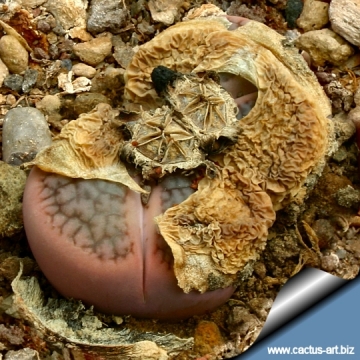 Lithops turbiniformis var. brunneo-violacea (Lithops hookeri var. subfenestrata C019 (syn. brunneoviolacea) TL: 40 km SW of Griquatown, South Africa) Photo by: Cactus Art
Lithops turbiniformis var. brunneo-violacea (Lithops hookeri var. subfenestrata C019 (syn. brunneoviolacea) TL: 40 km SW of Griquatown, South Africa) Photo by: Cactus Art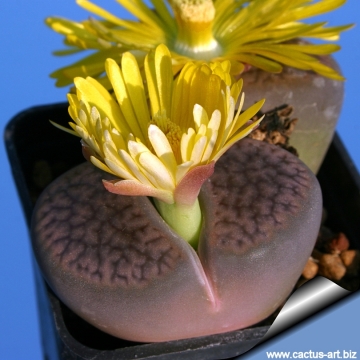 Lithops turbiniformis var. brunneo-violacea (Lithops hookeri var. subfenestrata C019 (syn. brunneoviolacea) TL: 40 km SW of Griquatown, South Africa) Photo by: Cactus Art
Lithops turbiniformis var. brunneo-violacea (Lithops hookeri var. subfenestrata C019 (syn. brunneoviolacea) TL: 40 km SW of Griquatown, South Africa) Photo by: Cactus Art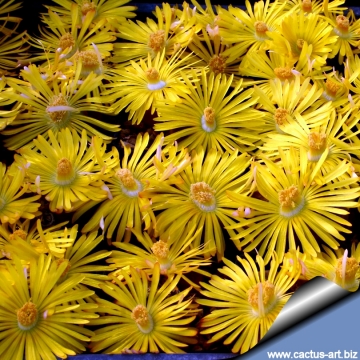 Lithops turbiniformis var. brunneo-violacea (Lithops hookeri var. subfenestrata C019 (syn. brunneoviolacea) TL: 40 km SW of Griquatown, South Africa) Photo by: Cactus Art
Lithops turbiniformis var. brunneo-violacea (Lithops hookeri var. subfenestrata C019 (syn. brunneoviolacea) TL: 40 km SW of Griquatown, South Africa) Photo by: Cactus Art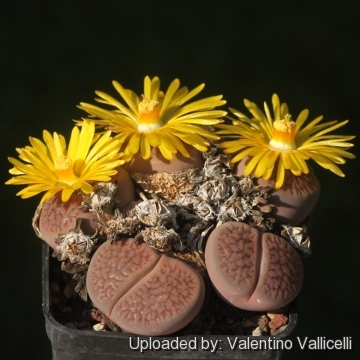 Lithops turbiniformis var. brunneo-violacea (Lithops hookeri var. subfenestrata C019 (syn. brunneoviolacea) TL: 40 km SW of Griquatown, South Africa) Photo by: Valentino Vallicelli
Lithops turbiniformis var. brunneo-violacea (Lithops hookeri var. subfenestrata C019 (syn. brunneoviolacea) TL: 40 km SW of Griquatown, South Africa) Photo by: Valentino Vallicelli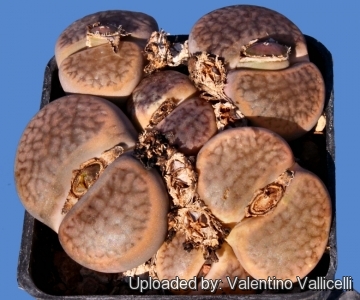 Lithops turbiniformis var. brunneo-violacea (Lithops hookeri var. subfenestrata C019 (syn. brunneoviolacea) TL: 40 km SW of Griquatown, South Africa) Photo by: Valentino Vallicelli
Lithops turbiniformis var. brunneo-violacea (Lithops hookeri var. subfenestrata C019 (syn. brunneoviolacea) TL: 40 km SW of Griquatown, South Africa) Photo by: Valentino Vallicelli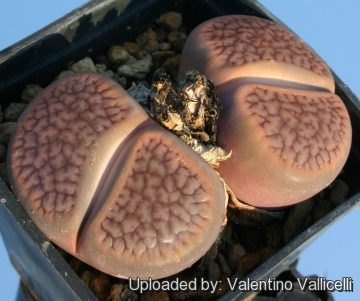 Lithops turbiniformis var. brunneo-violacea (Lithops hookeri var. subfenestrata C019 (syn. brunneoviolacea) TL: 40 km SW of Griquatown, South Africa) Photo by: Valentino Vallicelli
Lithops turbiniformis var. brunneo-violacea (Lithops hookeri var. subfenestrata C019 (syn. brunneoviolacea) TL: 40 km SW of Griquatown, South Africa) Photo by: Valentino Vallicelli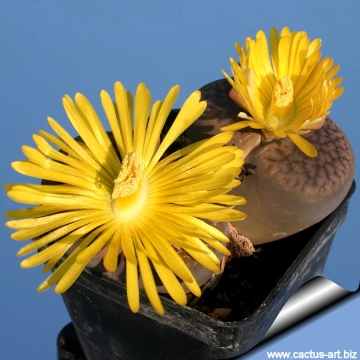 Lithops turbiniformis var. brunneo-violacea (Lithops hookeri var. subfenestrata C019 (syn. brunneoviolacea) TL: 40 km SW of Griquatown, South Africa) Photo by: Cactus Art
Lithops turbiniformis var. brunneo-violacea (Lithops hookeri var. subfenestrata C019 (syn. brunneoviolacea) TL: 40 km SW of Griquatown, South Africa) Photo by: Cactus Art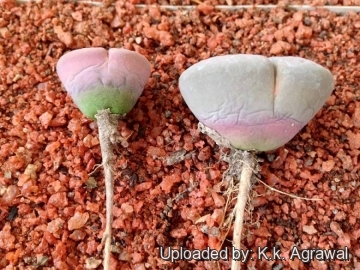 I took out Lithops Hookeri subfenestrata 'brunneoviolace' for transplanting and found beautiful colors on the sides of the plant (Lithops hookeri var. subfenestrata C019 (syn. brunneoviolacea) TL: 40 km SW of Griquatown, South Africa) Photo by: K.k. Agrawal
I took out Lithops Hookeri subfenestrata 'brunneoviolace' for transplanting and found beautiful colors on the sides of the plant (Lithops hookeri var. subfenestrata C019 (syn. brunneoviolacea) TL: 40 km SW of Griquatown, South Africa) Photo by: K.k. AgrawalCultivation and Propagation: Lithops hookeri is a summer growing species with dry rest period over winter. Easy to grow it tolerates a degree more excess water than some particular hydrophobic species, even so it must have a very open mineral, fast draining mix with little compost and a high degree of grit, coarse sand, small lava gravel or pebbles. Give them the maximum amount of light you are able to give them, but care should be taken about exposing them to the full blast of the sun rays in summer. Such tiny plants can easily get scorched or broiled and their appearance spoiled (this may not matter in the wild, where the Lithops have probably shrunk into the ground and becomes covered with sands).
The basic cultivation routine is: Stop watering after flowering. Start watering after the old leaves completely dry. (Usually late March or Early April) Water freely during the growing season, soak the compost fully but allow it to dry out between waterings, no water when cold. Some growers fertilize frequently, some hardly ever. Keep them dry during the winter. Nearly all problems occur as a result of overwatering and poor ventilation especially when weather conditions are dull and cool or very humid. If too much water is supplied the plants will grow out of character, bloat, split and rot. Keep them in small pots as solitary clumps or as colonies in large, shallow terracotta seed pans.
Remarks After flowering in the autumn and extending through winter season the plant doesn’t need watering, but they will still be growing, the new bodies will be increasing in size extracting water from the outer succulent leaves, allowing them to shrivel away. In fact the plant in this time extracts water and nutrient stored in the outer succulent leaves, allowing them to dehydrate relocating the water to the rest of the plant and to the new leaves that form during this period until the old leaves are reduced to nothing more than "thin papery shells".
Your Photos
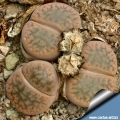
by Cactus Art
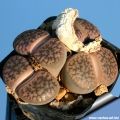
by Cactus Art
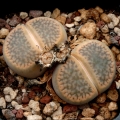
by Valentino Vallicelli
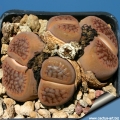
by Cactus Art






















